New Housing Developments in the City Center of Guadalajara (Mexico): An Analysis from the Perspective of Collective and Sustainable Dwelling
Abstract
1. Introduction: Research Context
2. Theoretical Background: Collective Housing, Dwelling and the City
3. Materials and Methods
3.1. Research Design
3.2. Research Objective
3.3. Case Study Context. Urban Development and Housing in Guadalajara: From Horizontal to Vertical, from the Periphery to the Center
3.4. Selected Study Cases. Eleven New Housing Developments in Guadalajara Downtown
4. Findings and Discussion
4.1. Favorable Urban Environment
4.2. Relationship between the Buildings and Their Immediate Context
4.3. Lack of Appropriation Spaces in Intermediate Scales
4.4. Lack of Innovation in Housing Typologies
4.5. Gender
4.6. Management
5. Conclusions
Funding
Institutional Review Board Statement
Informed Consent Statement
Data Availability Statement
Acknowledgments
Conflicts of Interest
References
- Cireddu, A.; Díaz, V. Las urbanizaciones residenciales cerradas, una forma de habitar la ciudad contemporánea. In Expresión Territorial de la Fragmentación y Segregación; Concepción, A., Gómez, R., Hidalgo, D.R., Eds.; Universidad Autónoma del Estado de Morelos: Cuernavaca, Mexico, 2016. [Google Scholar]
- Diaz, V.; Cireddu, A. La proximidad urbana a partir del análisis de la vida cotidiana con perspectiva de género en el barrio de Huentitán el Alto, Guadalajara (México). Quid 16 2019, 11, 281–315. [Google Scholar]
- Cireddu, A.; Díaz, V.; Gleason, J.A. La ciudad abierta y la ciudad cerrada: Análisis de la vida cotidiana en el barrio de Huentitán El Alto, Guadalajara, México. In Segregación y Fragmentación Socioespacial en Ciudades. Nuevas Formas de Habitar la Ciudad; Díaz, V., Nápoles, D., Escamilla, L., Eds.; Universidad de Guadalajara: Guadalajara, Mexico, 2020; pp. 229–262. [Google Scholar]
- Johnson, M.P. Environmental impacts of urban sprawl: A survey of the literature and proposed research agenda. Environ. Plan. A 2001, 33, 717–735. [Google Scholar] [CrossRef]
- Jacobs, J. The Death and Life of Great American Cities; Random House, Pimlico: London, UK, 1961; pp. 474–2000. [Google Scholar]
- Jenks, M. Dimensions of the Sustainable City; Springer: Dordrecht, The Netherlands, 2009; 2p. [Google Scholar]
- Hofstad, H. Compact City Development: High Ideals and Coming Practices. Eur. J. Spat. Dev. 2012, 1, 1–23. Available online: https://archive.nordregio.se/en/News/Compact-city-development/index.html (accessed on 24 March 2021).
- Jansson, M. Green Space in Compact Cities: The Benefits and Values of Urban Ecosystem Services in Planning. Nord. J. Archit. Res. 2014, 26, 139–160. [Google Scholar]
- Iracheta, A.X. Planeación y desarrollo: Una visión del futuro: Problemas y perspectivas del desarrollo y la urbanización en México y el Estado de México: Plaza y Valdés. EURE 1997. [Google Scholar] [CrossRef]
- Iracheta, A. 3.7 Reforma Metropolitana en Ciudad de México: Algunas Ideas Clave; Gómez-Álvarez, D., Rajack, R., López-Moreno, E., Lanfranchi, G., Eds.; Gobernanza Metropolitana: Santiago, Chile, 2019; 320p. [Google Scholar]
- OECD. Compact City Policies: A Comparative Assessment, OECD Green Growth Studies; OECD Publishing: Paris, France, 2012. [Google Scholar]
- Westerink, J.; Haase, D.; Bauer, A.; Ravetz, J.; Jarrige, F.; Aalbers, C.B.E.M. Dealing with Sustainability Trade-Offs of the Compact City in Peri-Urban Planning Across European City Regions. Eur. Plan. Stud. 2013, 21, 473–497. [Google Scholar] [CrossRef]
- Jabareen, Y.R. Sustainable urban forms: Their typologies, models, and concepts. J. Plan. Educ. Res. 2006, 26, 38–52. [Google Scholar] [CrossRef]
- Jenks, M.; Burton, E.; Williams, K. (Eds.) Compact cities and sustainability: An introduction. In The Compact City: A Sustainable Urban Form? Spon Press: London, UK, 1996; pp. 3–8. [Google Scholar]
- Randolph, B. Delivering the compact city in Australia: Current trends and future implications. Urban Policy Res. 2006, 24, 473–490. [Google Scholar] [CrossRef]
- Burton, E. The compact city: Just or just compact: A preliminary analysis. Urban Stud. 2000, 37, 1969–2001. [Google Scholar] [CrossRef]
- Colding, J. The role of ecosystem services in contemporary urban planning. In Urban Ecology: Patterns, Processes and Applications; Niemela, J., Ed.; Oxford University Press: Oxford, UK, 2011; pp. 228–237. [Google Scholar]
- Jenks, M.; Burton, E.; Williams, K. Achieving Sustainable Urban Form; E & FN Spon: London, UK, 2000. [Google Scholar]
- Newman, P.; Kenworthy, J. Cities and Automobile Dependence: An International Sourcebook; Gower Publishing Co.: Aldershot, UK, 1989. [Google Scholar]
- Ochoa-Jurado, R. En Ciudad y Salud: El entorno urbano, como promotor de la calidad de vida. In Resiliencia Urbana y Seguridad Alimentaria en el Área Metropolitana de Guadalajara; Cap. 2: Congreso Internacional XI SIUMA; Universidad de Guadalajara: Guadalajara, Mexico, 2015; ISBN 978-607-742-434-5. [Google Scholar]
- UN Hábitat. State of the World’s Cities 2012/13. 2013. Available online: www.unhabitat.org (accessed on 15 December 2020).
- Heidegger, M. Building, dwelling, thinking (1993). In Basic Writings: Martin Heidegger; Farrell, D., Ed.; HarperCollins Publishers: New York, NY, USA, 1954; pp. 343–364. [Google Scholar]
- Montaner, J.M. La Arquitectura de la Vivienda Colectiva: Políticas y Proyectos en la Ciudad Contemporánea; Reverté: Barcelona, Spain, 2015. [Google Scholar]
- Hayden, D. Redesigninig the American Dream: The Future of Housing, Work and Family Life; W. W. Norton Company: New York, NY, USA, 2002. [Google Scholar]
- Hayden, D. Building Suburbia: Green Fields and Urban Growth, 1820–2000; Pantheon Books: New York, NY, USA, 2003. [Google Scholar]
- Muxí, Z. (Ed.) Postsuburbia; Comanegra: Barcelona, Spain, 2013. [Google Scholar]
- Duhau, E.; Giglia, A. Las Reglas del Desorden: Habitar la Metropolis; Siglo XXI Editores: Mexico City, Mexico, 2008. [Google Scholar]
- Cabrales, L.F.; Canosa, E. Segregación residencial y fragmentación urbana: Los fraccionamientos cerrados en Guadalajara. Espiral 2001, VII, 223–253. [Google Scholar] [CrossRef]
- Caldeira, T. Ciudad de Muros; Gedisa: Barcelona, Spain, 2007. [Google Scholar]
- Blakely, E.J.; Snyder, M.G. Divided we fall: Gated and walled communities in the United States. In Architecture of Fear; Ellin, N., Ed.; Princeton Architectural Press: New York, NY, USA, 1997. [Google Scholar]
- Hidalgo-Dattwyler, R.; Arenas, F. Negocios Inmobiliarios, Transformación Metropolitana y la Nueva Morfología de Santiago de Chile: Desde la Renovación del Espacio Central a los Barrios Cerrados de la Periferia; Alvarado, C., Ed.; Pontifical Catholic University of Chile: Santiago, Chile, 2012; pp. 279–293. [Google Scholar]
- Casanovas, R.; Gutiérrez, B. La vida cotidiana en las áreas residenciales monofuncionales de baja densidad. In Postsuburbia: Rehabilitación de Urbanizaciones Monofuncionales de Baja Densidad; Zaida, M., Ed.; Comanegra: Barcelona, Spain, 2013; pp. 25–35. [Google Scholar]
- Horelli, L. The Role of Shared Space for the Building and Maintenance of Community from the Gender Perspective—A Longitudinal Case Study in a Neighbourhood of Helsinki; Aalto University: Espoo, Finland, 2013. [Google Scholar]
- Miguélez, F.; Torns, T. Introducción al análisis del trabajo y de la vida cotidiana. Pap. Rev. Sociol. 1998, 55, 9–25. [Google Scholar]
- Miralles-Guasch, C.; Marquet, O. Dinámicas de proximidad en ciudades multifuncionales. Ciudad. Territorio Estud. Territoriales 2013, 177, 503–512. [Google Scholar]
- Aristondo, G.L. Cooperativismo, autoayuda y autogestión: Una alternativa uruguaya para la vivienda de interés social. Scripta Nova. 2003, VII, 146(099). [Google Scholar]
- Vestbro, D.; Horelli, L. Design for Gender Equality: The History of Co-Housing Ideas and Realities; Aalto University: Espoo, Finland, 2012. [Google Scholar]
- Giorgi, E. The Co-Housing Phenomenon: Environmental Alliance in Times of Changes; Springer: Cham, Switzerland, 2020. [Google Scholar]
- Muxí, Z. Beyond the Threshold: Women, Houses, Cities; Avenue Bookstore: Albert Park, Australia, 2021. [Google Scholar]
- Hayden, D. The Grand Domestic Revolution. A History of Feminist Designs for American Homes, Neighborhoods, and Cities; MIT Press: Cambridge, MA, USA, 1981. [Google Scholar]
- ‘Covivienda’ en Barcelona. Available online: https://www.elperiodico.com/es/opinion/20161219/covivienda-en-barcelona-5700923 (accessed on 24 March 2021).
- De Jorge-Huertas, V. Collaborative designing of communities: Helsinki and Zurich Pioneers. ACE Arch. City Environ. 2020, 15, 9012. [Google Scholar] [CrossRef]
- Smithson, A. Mat-buildings: How to recognise and read it. Archit. Des. 1974, 9, 573-291. [Google Scholar]
- De Jorge-Huertas, V. Mat-hybrid housing: Two case studies in Terni and London. Front. Arch. Res. 2018, 7, 276–291. [Google Scholar] [CrossRef]
- Brau, G. How to Analyze and Evaluate Mat Housing; Arquilecturas: Barcelona, Spain, 2016. [Google Scholar]
- Montaner, J.M.; Múxí, Z.; Falagán, D. Tools for Inhabiting the Present: Housing in the 21st Century; Actar: Barcelona, Spain, 2011. [Google Scholar]
- Rocca, M.E. La construcción de la categoría de colugar. In Proceedings of the II Congreso de Vivienda Colectiva Sostenible, Sao Paulo, Brazil, 23 May 2016. [Google Scholar]
- Havik, K.; Teerds, H.; Tielens, G. Building Atmospheres. OASE J. Archit. 2013, 91, 3–12. [Google Scholar]
- Aceves, J.; De la Torre, R.; Safa, P. Fragmentos urbanos de una misma ciudad: Guadalajara. Espiral 2004, XI, 277–320. [Google Scholar] [CrossRef]
- Camus, M. Vivir en el coto. In Fraccionamientos Cerrados, Mujeres y Colonialidad; Universidad de Guadalajara: Guadalajara, Mexico, 2015. [Google Scholar]
- Olivares, A.; Díaz, V. Los imaginarios de la modernidad en la colonia Chapalita en Guadalajara, Jalisco, México. In La Arquitectura Moderna Desde la Calle; Méndez, E.S., González, R.D., Olivares, A.I.G., Eds.; UdG: Guadalajara, Mexico, 2013. [Google Scholar]
- Cabrales, L.F. Tendencias Recientes de las Urbanizaciones Cerradas y Polarización Residencial en Guadalajara: Texto Redactado en Ocasión del Curso: Segregación y Mercados de Suelo, Patrones Emergentes de Segregación: Los Casos de México y Chile, México; Café de las Ciudades: Buenos Aires, Argentina, 2006. [Google Scholar]
- Díaz, V. Efectos Espaciales y Funcionales de las Nuevas Centralidades en la Ciudad Policéntrica; UdG: Guadalajara, Mexico, 2015. [Google Scholar]
- Borsdorf, A. Cómo modelar el desarrollo y la dinámica de la ciudad latinoamericana. EURE (Santiago) 2003, 29, 37–49. [Google Scholar] [CrossRef]
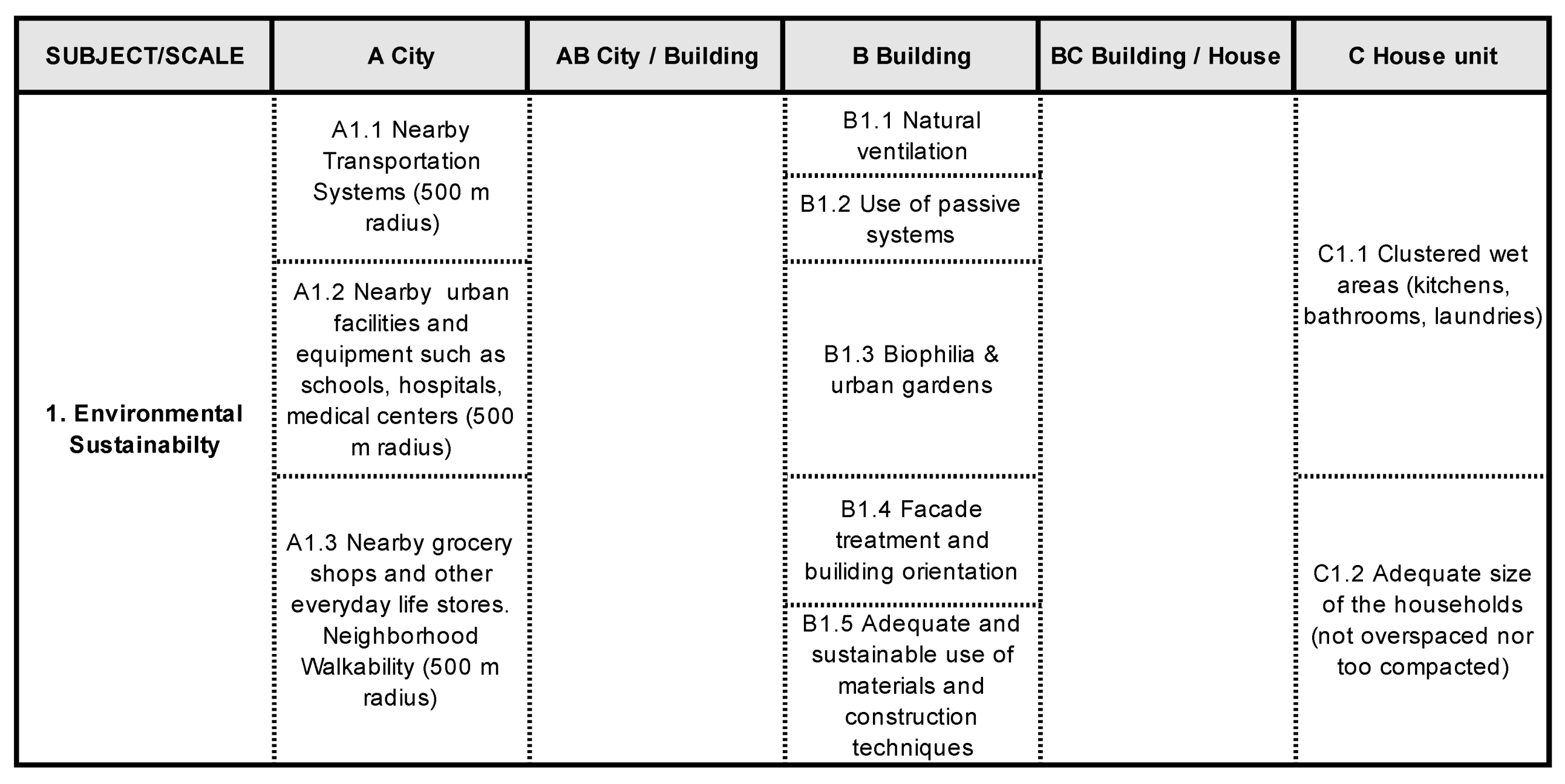
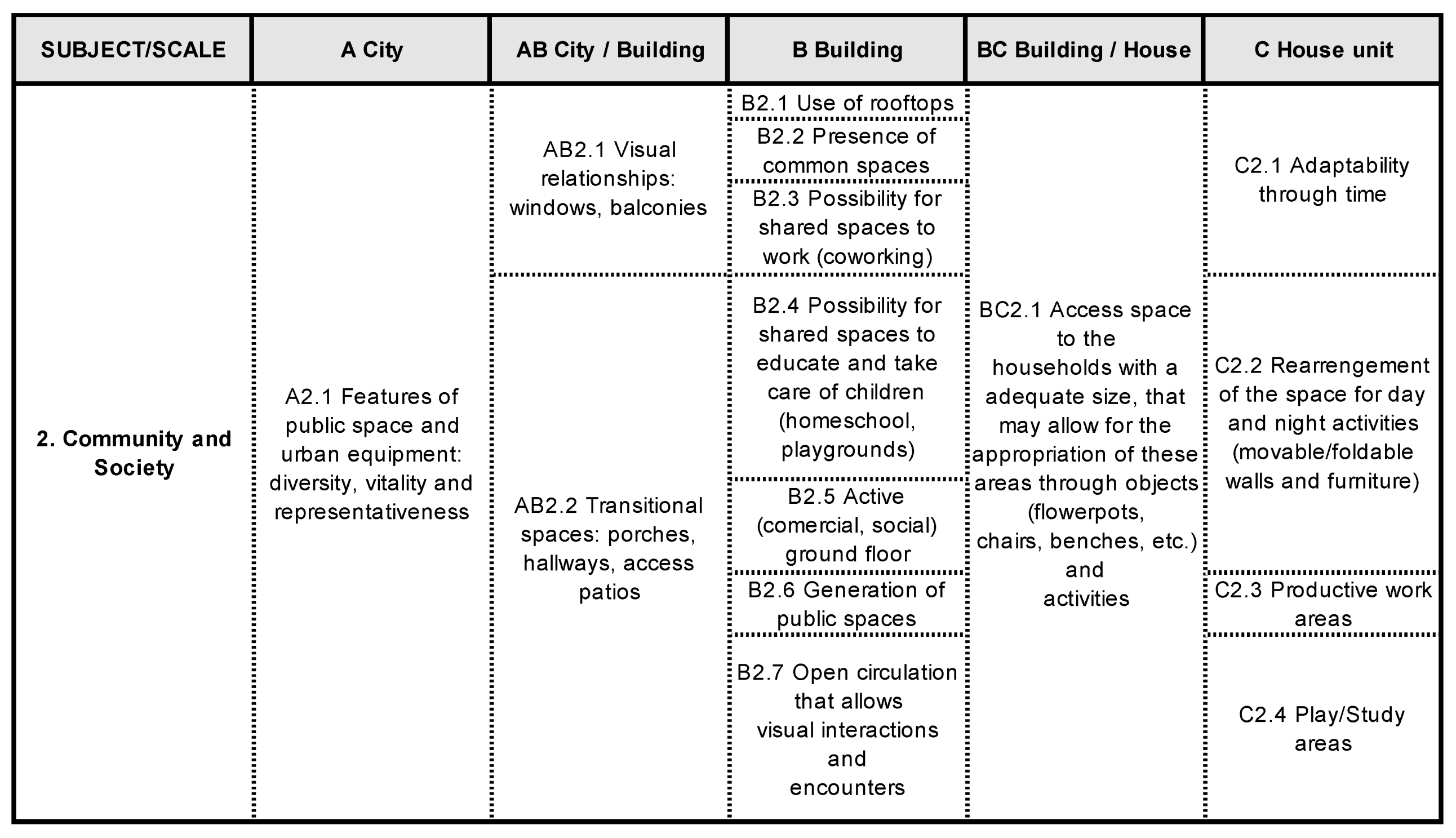
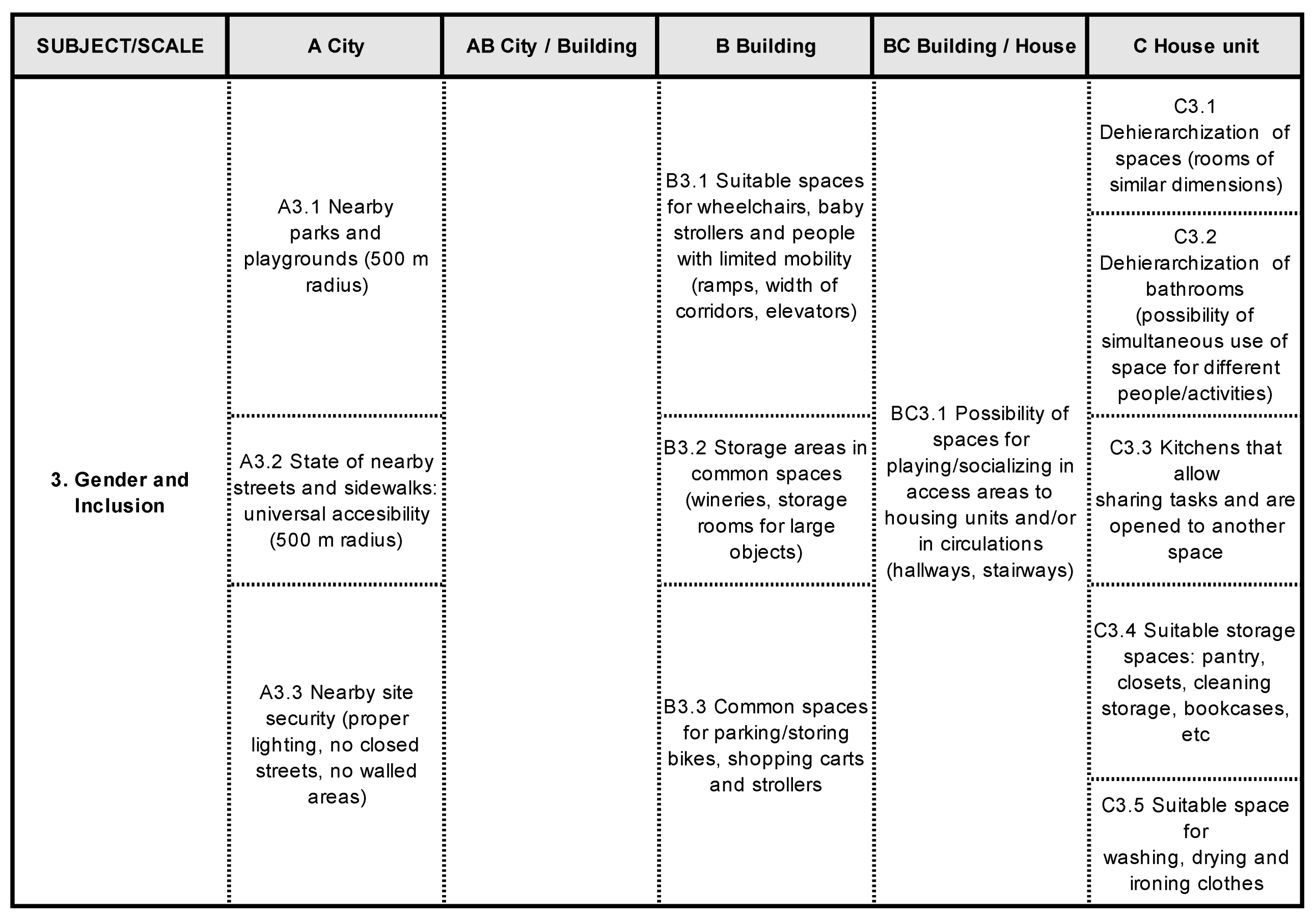
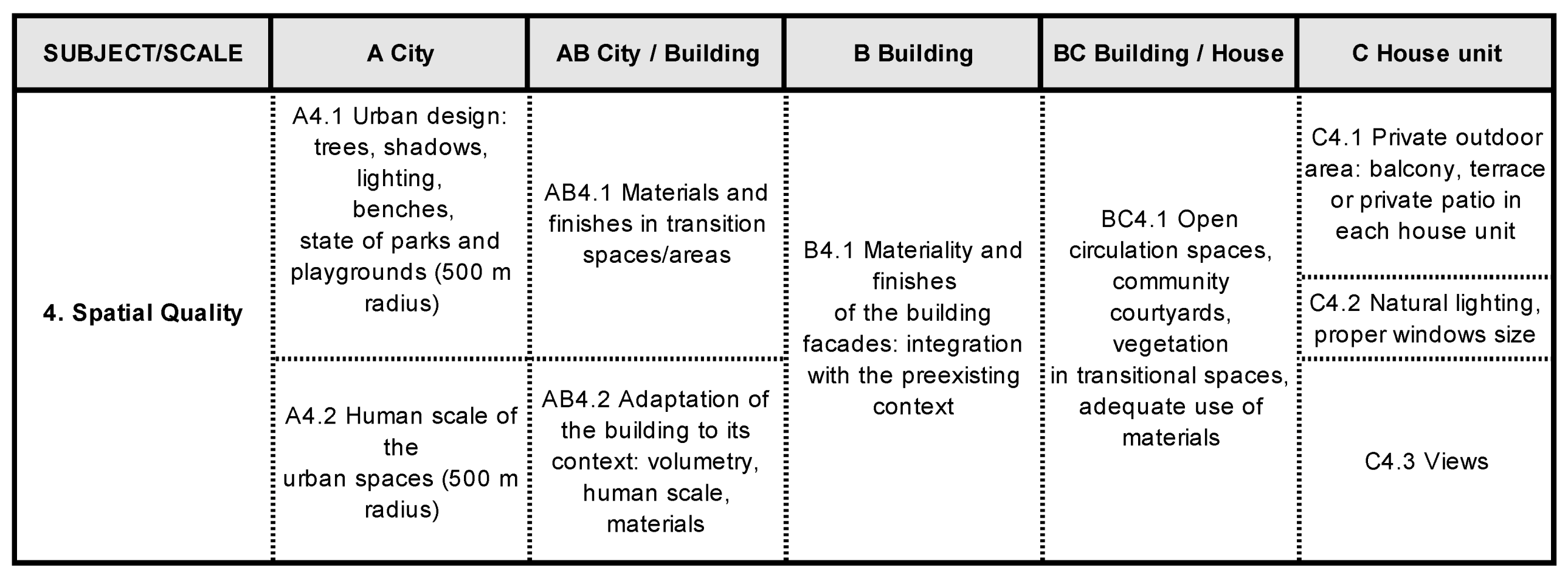
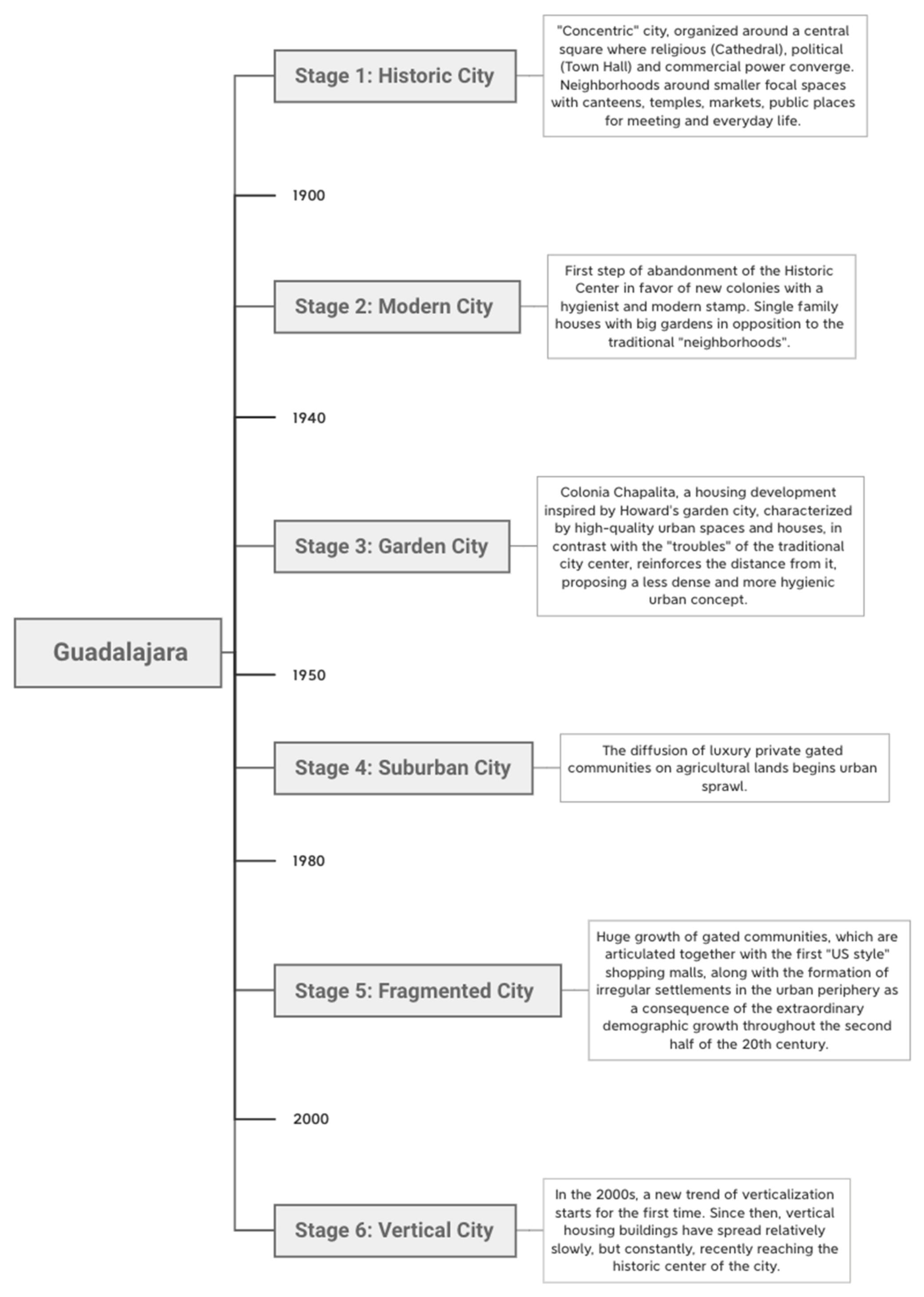
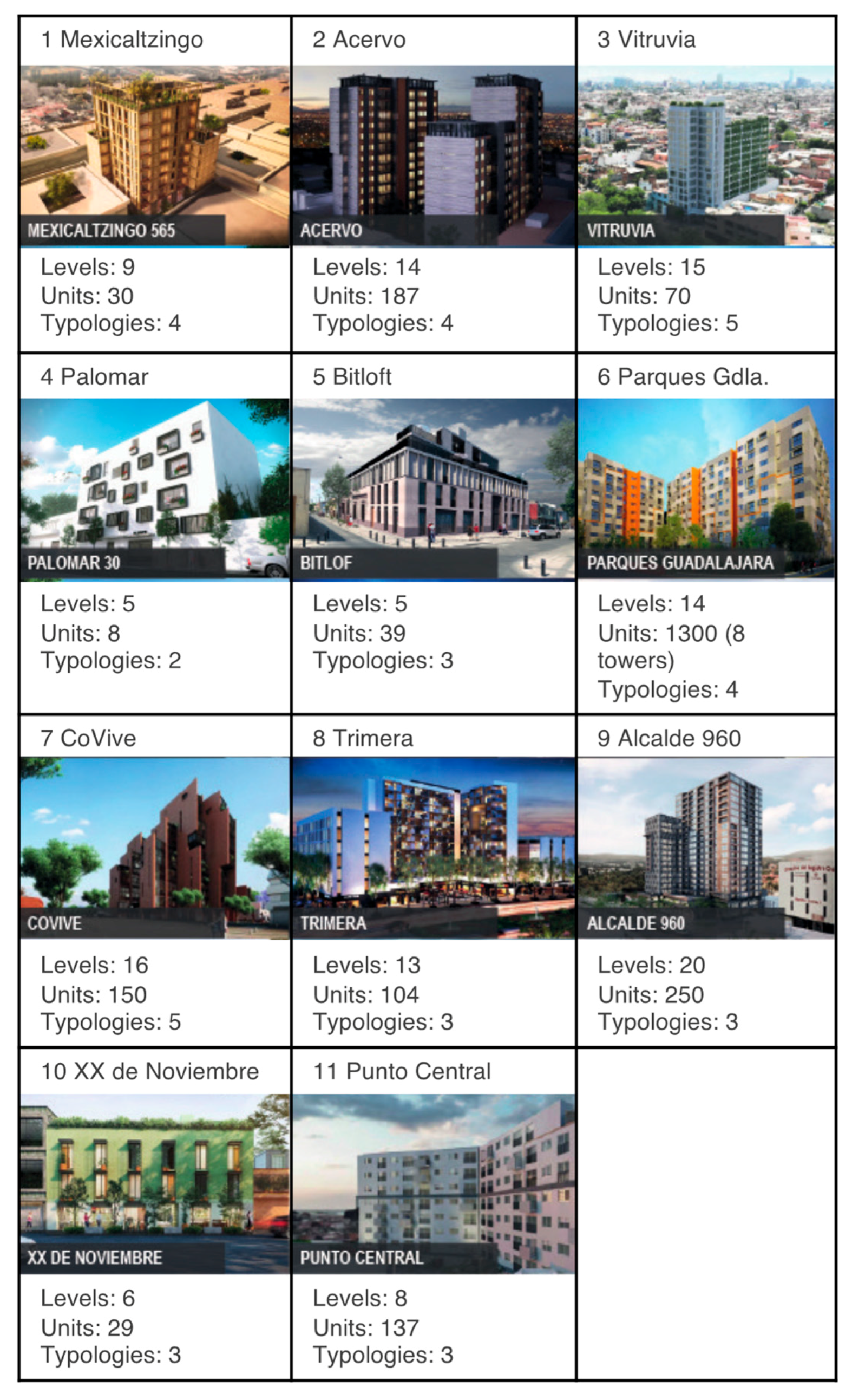
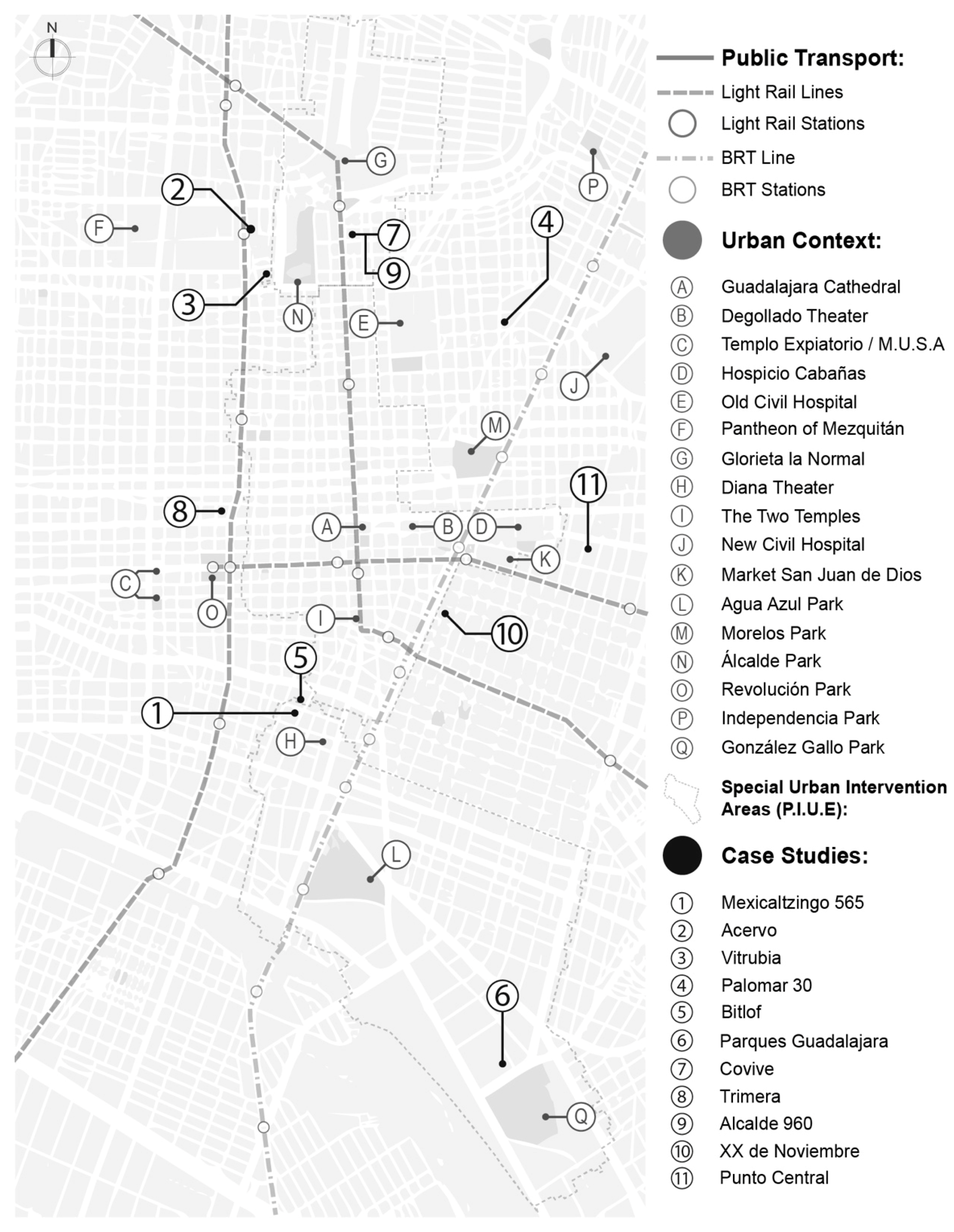
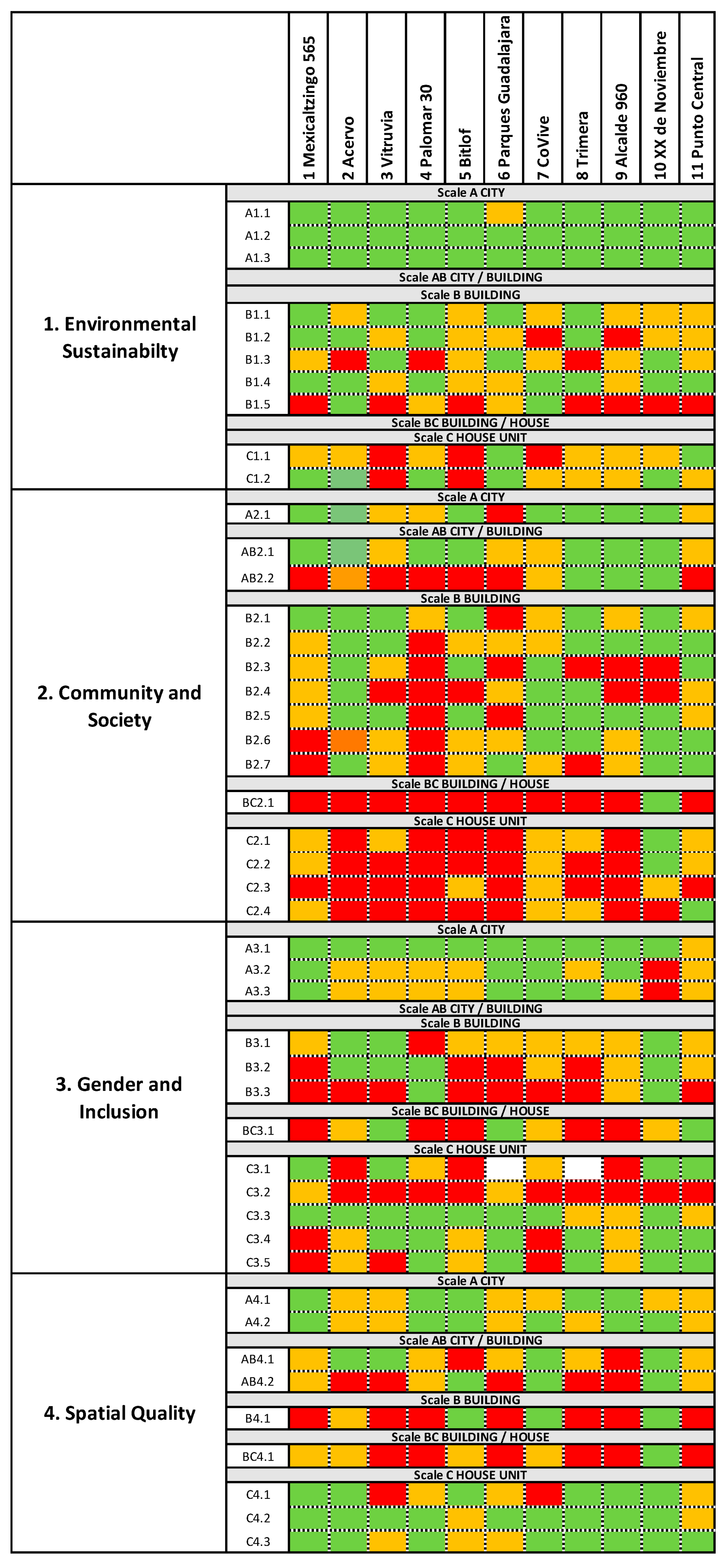
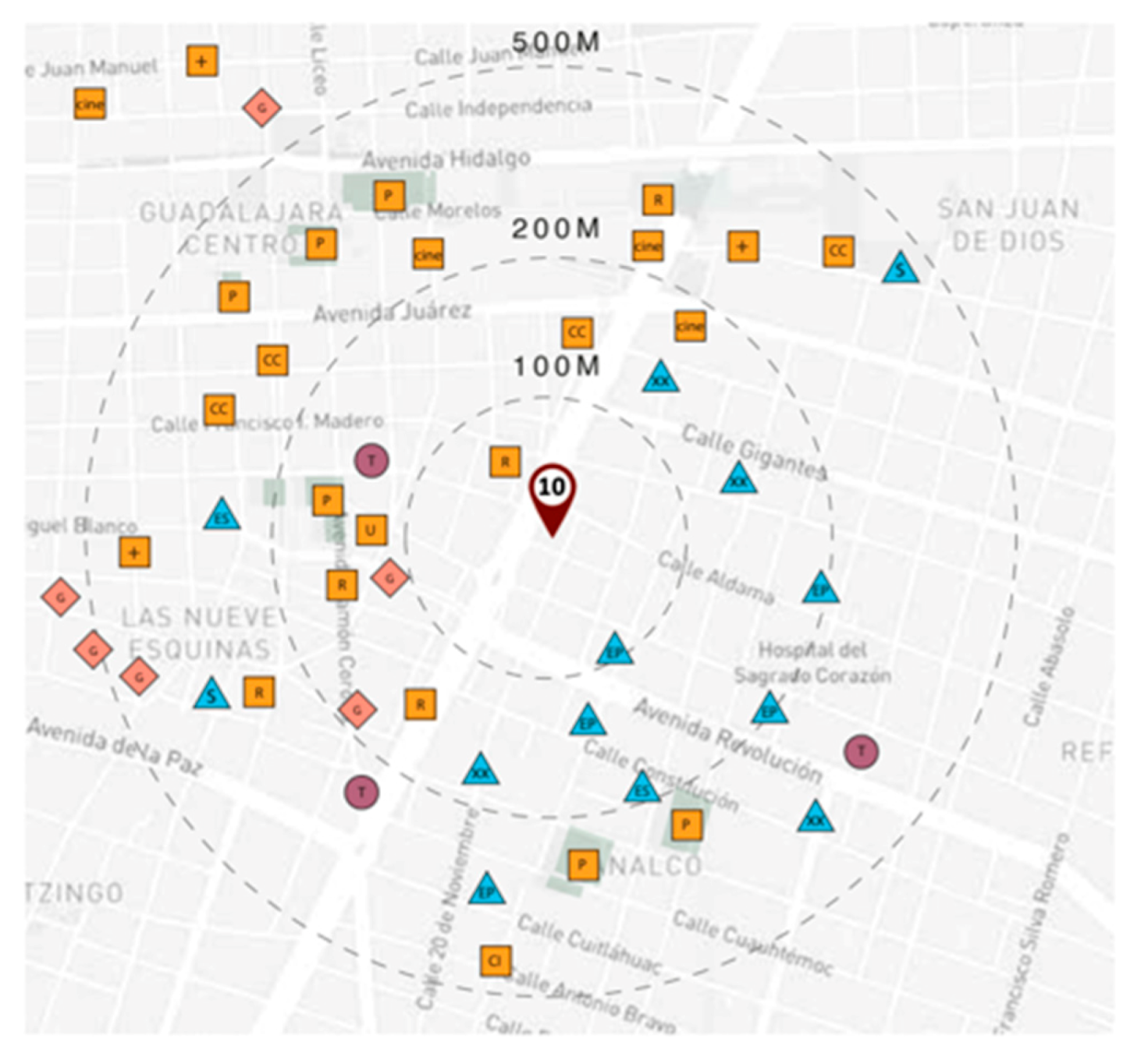
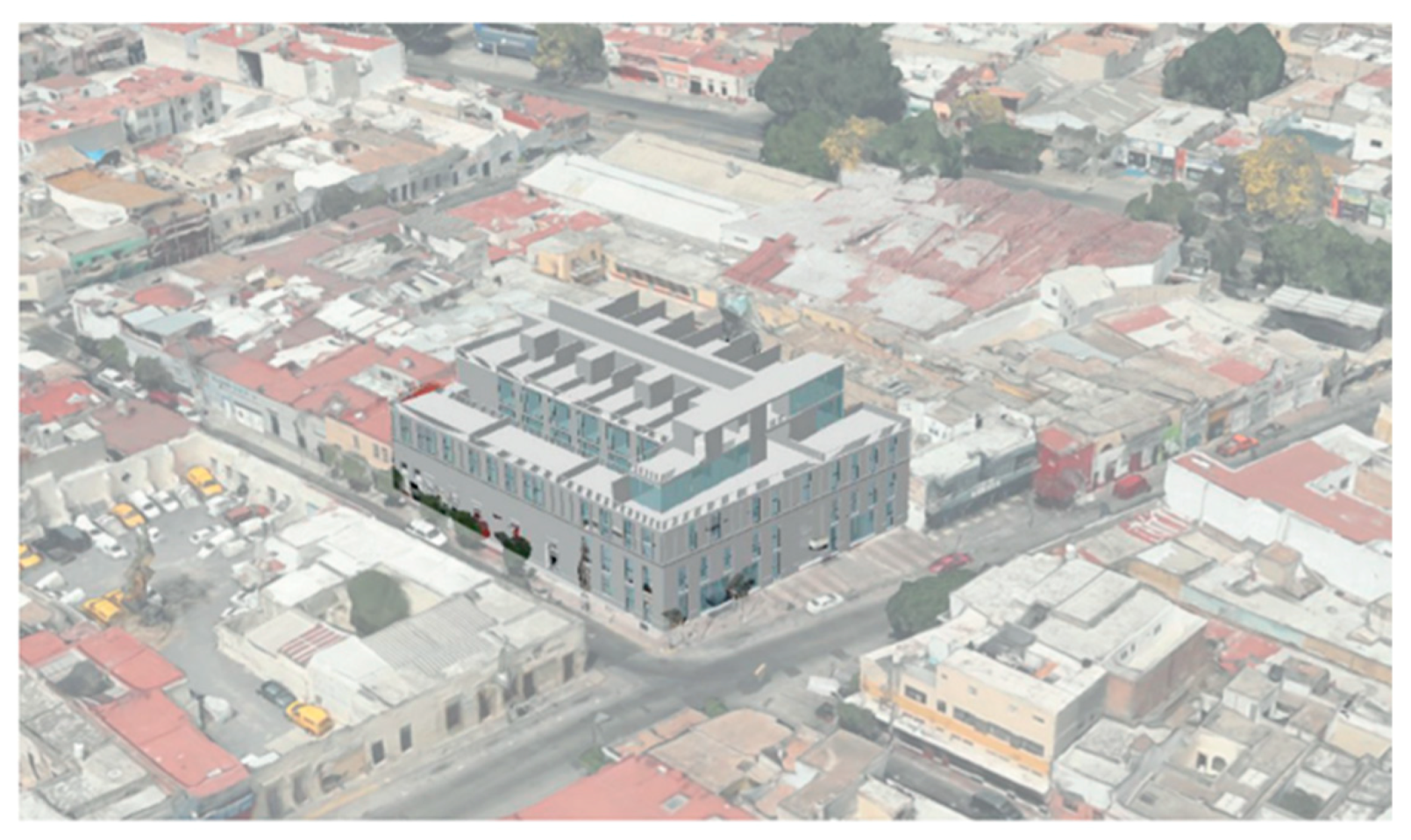
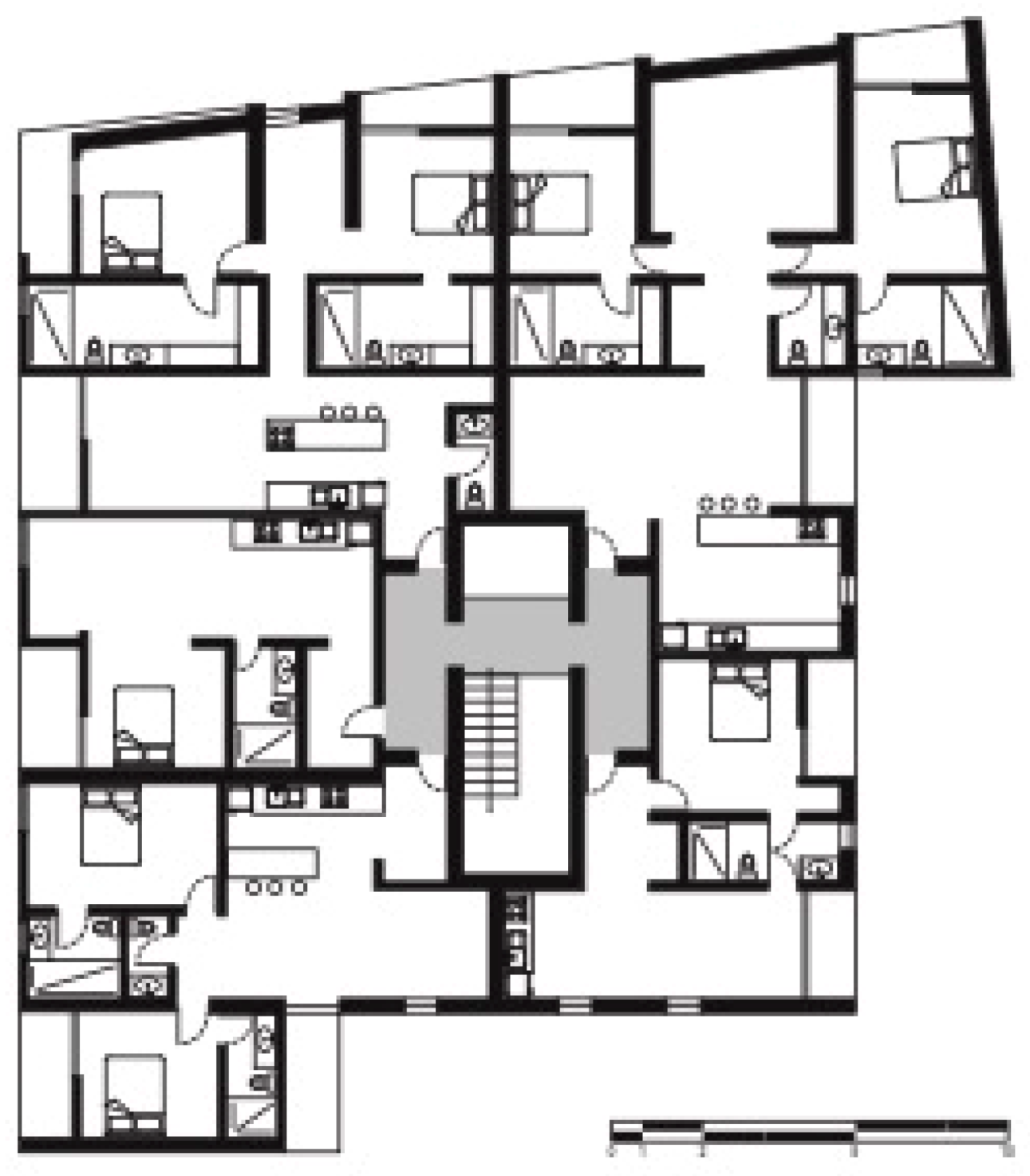
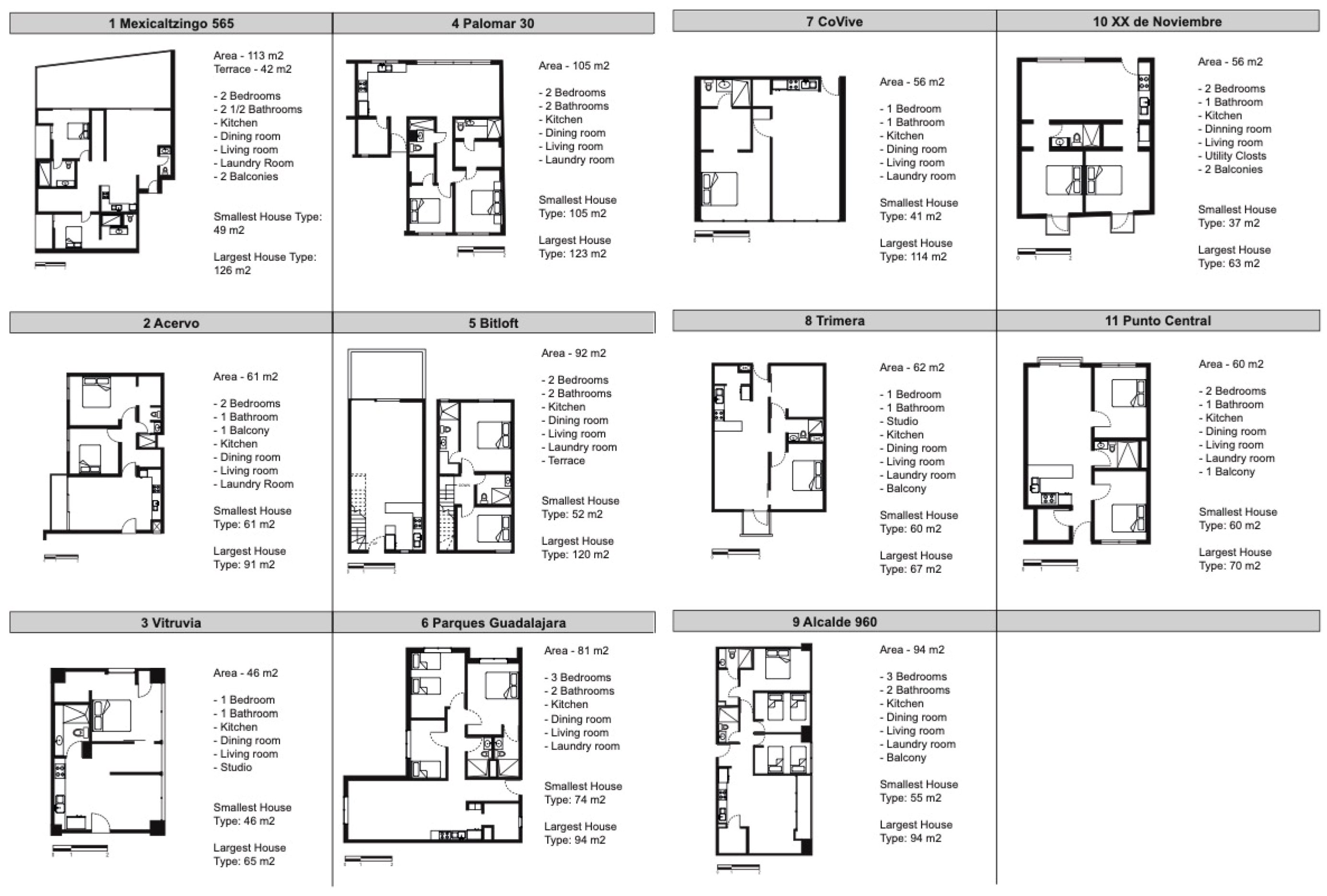
| Main Scales | A City | Nearby urban context (500 m radius around the building) |
| B Building | Building’s common spaces and circulations | |
| C Housing Unit | It is the interior of the house | |
| Intermediate Scales | AB City/Building | It is the transition scale between the building and the immediate urban context |
| BC Building/Housing unit | It is the transition scale that represents the connection between the common spaces and circulations of the building and the house. |
Publisher’s Note: MDPI stays neutral with regard to jurisdictional claims in published maps and institutional affiliations. |
© 2021 by the author. Licensee MDPI, Basel, Switzerland. This article is an open access article distributed under the terms and conditions of the Creative Commons Attribution (CC BY) license (https://creativecommons.org/licenses/by/4.0/).
Share and Cite
Cireddu, A. New Housing Developments in the City Center of Guadalajara (Mexico): An Analysis from the Perspective of Collective and Sustainable Dwelling. Buildings 2021, 11, 168. https://doi.org/10.3390/buildings11040168
Cireddu A. New Housing Developments in the City Center of Guadalajara (Mexico): An Analysis from the Perspective of Collective and Sustainable Dwelling. Buildings. 2021; 11(4):168. https://doi.org/10.3390/buildings11040168
Chicago/Turabian StyleCireddu, Alessandra. 2021. "New Housing Developments in the City Center of Guadalajara (Mexico): An Analysis from the Perspective of Collective and Sustainable Dwelling" Buildings 11, no. 4: 168. https://doi.org/10.3390/buildings11040168
APA StyleCireddu, A. (2021). New Housing Developments in the City Center of Guadalajara (Mexico): An Analysis from the Perspective of Collective and Sustainable Dwelling. Buildings, 11(4), 168. https://doi.org/10.3390/buildings11040168






